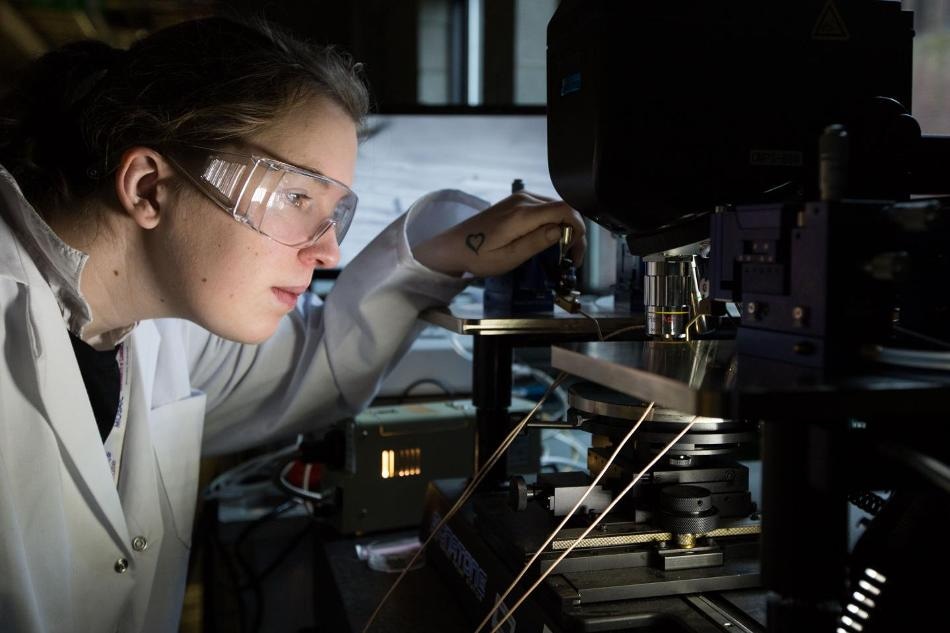Dec 5 2017
According to a study performed at University of Limerick (UL), Ireland, mobile phone speakers and motion detectors in video games and cars may soon be powered by electricity produced from low cost and sustainable biomaterials.
 Mobile phone speakers and motion detectors in cars and video games may soon be powered by electricity generated from low cost and sustainable biomaterials, according to research carried out at University of Limerick (UL), Ireland. Scientists at UL's Bernal Institute have discovered that the biomolecule glycine, when tapped or squeezed, can generate enough electricity to power electrical devices in an economically viable and environmentally sustainable way. The research was published on Dec. 4, 2017 in leading international journal Nature Materials. Pictured is Sarah Guerin, Science Foundation Ireland funded post-graduate researcher at the Bernal Institute, UL. (CREDIT - Sean Curtin TrueMedia)
Mobile phone speakers and motion detectors in cars and video games may soon be powered by electricity generated from low cost and sustainable biomaterials, according to research carried out at University of Limerick (UL), Ireland. Scientists at UL's Bernal Institute have discovered that the biomolecule glycine, when tapped or squeezed, can generate enough electricity to power electrical devices in an economically viable and environmentally sustainable way. The research was published on Dec. 4, 2017 in leading international journal Nature Materials. Pictured is Sarah Guerin, Science Foundation Ireland funded post-graduate researcher at the Bernal Institute, UL. (CREDIT - Sean Curtin TrueMedia)
Researchers at UL's Bernal Institute have discovered that the biomolecule glycine, when squeezed or tapped, can produce sufficient electricity to power electrical devices in an economically feasible and environmentally sustainable way. The research details can be found in the December 4 issue of the journal Nature Materials.
Glycine is the most basic amino acid. It occurs in almost all forestry and agro residues. It can be created at less than one per cent of the cost of presently used piezoelectric materials.
Piezoelectric materials create electricity in reaction to pressure, and vice versa. They are extensively used in phones, cars, and remote controls for games consoles. In contrast to glycine, these materials are usually synthetic and often comprise toxic elements such as lithium or lead.
"It is really exciting that such a tiny molecule can generate so much electricity," said lead author Sarah Guerin, a post-graduate student at the Department of Physics and the Bernal Institute, UL.
"We used computer models to predict the electrical response of a wide range of crystals and the glycine number was off the charts. We then grew long, narrow crystals of glycine in alcohol," she added, "and we produced electricity just by tapping them."
The predictive models we are developing can save years of trial-and-error lab work. The modelling data tells us what kinds of crystals to grow and where best to cut and press those crystals to generate electricity.
Dr Damien Thompson, PhD supervisor
Co-author and Science Foundation Ireland (SFI) Centre for Medical Devices (CURAM) investigator Professor Tofail Syed said: "We also have a pending patent that translates our findings to applications such as biodegradable power generation, devices detecting diseases inside of the body and physiologically controlled drug pumps".
Earlier, Bernal researchers discovered piezoelectricity in the globular protein lysozyme, found in egg-white, tears and saliva, and hydroxyapatite, a component of bone.
"The current finding extends the technology towards pragmatic, low-cost, renewable sources for electricity generation," according to Professor Luuk van der Wielen, Director of the Bernal Institute and Bernal Professor of Biosystems Engineering and Design. "The finding translates the earlier Bernal scientists' world-leading contribution in bio-piezoelectricity towards a large-scale and affordable application potential."
UL's Department of Physics and Bernal Institute researchers continue to pioneer the use of biological crystals for electrical applications. This work places them at the forefront in the development of bio-piezoelectric devices.
Professor Edmond Magner, Dean of Science and Engineering at UL